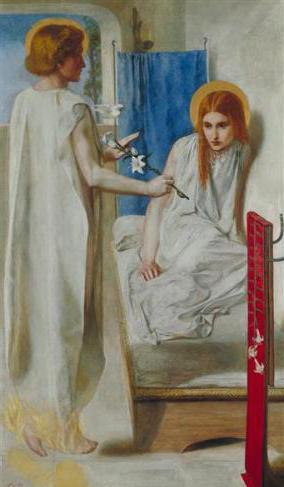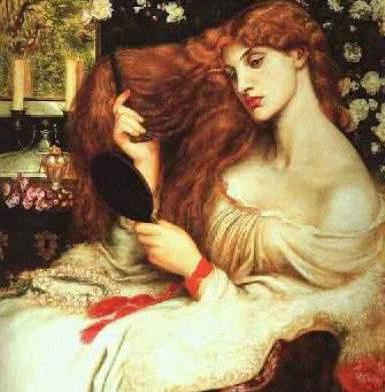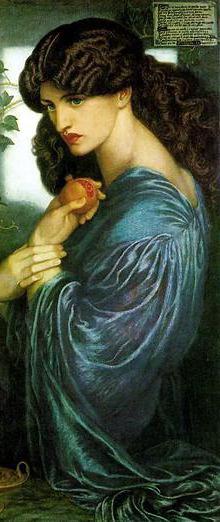Dante Gabriel Rossetti is an English poet, painter and illustrator who became one of the founders of the Brotherhood of the Pre-Raphaelites. In his works - paintings, poems and sonnets - he affirmed the purity of art, free of academism, singing the romance of the Early Renaissance. One of the favorite topics of the Pre-Raphaelites was unhappy love. And Rossetti's whole life, one way or another, revolved around her. Women inspired him, became the heroines of his paintings. However, the artist’s relationship with his lovers cannot be called simple, as, indeed, his whole life.
A family
Dante Gabriel Rossetti was born on May 12, 1828. His father, Gabriele Rossetti, was an Italian who, for political reasons, emigrated to England. He taught native language and literature at King's College. The father instilled in his son a love of Italian art, in particular, the creations of Dante Alighieri, which was reflected not only in the name of the boy, but also in the interests and aspirations that he would carry through his whole life.
Rossetti's mother, Francis Mary Lavinia Polidori, came from the family of Gaetano Polidori, a scientist and an emigrant from Italy. Since childhood, Dante Gabriel grew up in an atmosphere of art and early imbued with his fatherly passion for the works of the great poet and theologian, in whose honor he received his name. His sisters, as well as his brother, had literary talent. Maria Francesca became the author of The Shadow of Dante. The younger sister, Christina, became famous as a poetess. And brother William became the co-founder of the Pre-Raphaelite society and a literary critic.
Training
Dante Gabriel Rossetti, whose works began to be published when he was 15, studied at London King's College from 9 years old. The first creative steps of the young author were done in literature. At 5 years old Rossetti composed a drama, at 13 - a story. The artistic education of the boy was fragmentary. It began with a drawing school, where Rossetti entered at the age of 16 and where he studied under the guidance of D. S. Kotman. Then, from 1841, there was the Henry Sass Academy of Painting. Five years later, he became a student in the class of antique painting, which functioned at the Royal Academy.
Later, for some time, Dante's teacher is Medox Brown, a romantic artist, no less than Rossetti, passionate about literature. In 1848, he met Holman Hunt, who will help him hone his technique of working with oil paints during the creation of the first paintings of the Pre-Raphaelites.
Brotherhood education
Secret society, which gave rise to a new direction in poetry and painting, was formed in the 50s of the XIX century. Rossetti was then 18 years old. But thanks to temperament and a formed outlook on art, he was able to become the leader of the "Brotherhood of the Pre-Raphaelites." Together with Holman Hunt and young John Everett Milles, they conclude that the academicism that dominated the painting of that period is full of conventions and blind imitation. He smothers art, rejecting almost any innovations. According to the participants of the fraternity, only a return to the traditions of Italian art of the Early Renaissance could revive English painting.
Return to simplicity and cleanliness
The ideal for the Pre-Raphaelites was the manner of writing of the great artists who worked before Raphael: Perugino, Fra Angelico, Giovanni Bellini. The British admired the simplicity and sincerity of the paintings of the Italian masters of the Early Renaissance. Cleanliness and truth, veneration of the past and romanticism, rejection of the present and hostility to academism were combined in the works of the Pre-Raphaelites with a bold reading of established stories, and innovation in the painting technique. They focused on the masters of past eras, but they themselves gave rise to a trend that subsequently led to the development of modernity and gave rise to symbolism. The manifesto of the "Brotherhood of the Pre-Raphaelites" was published in the journal "Rostock", published from January to April 1850 by members of the society.
A new look at the usual plot
For the first time, the letters PRB, meaning Pre-Raphaelite Brotherhood ("Brotherhood of the Pre-Raphaelites"), appear on Rossetti's painting "The Youth of the Virgin Mary" (1848-1849). Models for the canvas were the mother and sister of the artist. And this is one of the differences between the Pre-Raphaelites and academicism: members of the fraternity in the pursuit of naturalness intentionally refused the services of professional models, preferring friends and relatives.

In the works of the Pre-Raphaelites often turned to biblical subjects. However, their reading was significantly different from the images established in art. An example of this is one of the paintings that Dante Gabriel Rossetti painted, the Annunciation. In academic painting, Virgin Mary has always been portrayed as an unearthly creature, accepting with reverence the gift of God and the responsibility associated with it. In the picture of Rossetti we see the most ordinary girl, frightened by an angel and the news he brought. Such an interpretation corresponded to the pre-Raphaelite desire for truthfulness and, naturally, caused a storm of indignation.
Rossetti - artist
The best works of Dante Gabriel Rossetti created in the period from the 1850s to 1860s. His style is well recognizable: outwardly static heroes whose face reflects a boiling inner work, a composition with several large figures in the foreground and the smallest elaboration of background elements. His paintings are full of characters born from a combination of real details and fantastic images. Rossetti did not use dark tones, minimized chiaroscuro - his paintings seem to glow, the colors are clean and bright. The artist skillfully used the line in his works, giving expressiveness or tenderness to the images with the help of clear or trembling contours.
Art historians define Rossetti's painting at the same time as decorative and monumental. The latter property is best expressed in the process of painting the walls located in one of the buildings of Oxford University. Selected plot - illustrations for the novel by Thomas Mallory “The Death of King Arthur”.
Rossetti - poet
Dante Gabriel Rossetti, whose poems are often placed on a par with Shakespeare's works, often used the same subjects for sonnets and canvases. Painting and poetry are inseparable in his work. He drew themes for paintings in verses and filled with special visualization of poems and sonnets. Rossetti observed the ideals of the Pre-Raphaelites in poetic works. He almost never spoke out on topical issues, filling poetry with medieval color. Dante Gabriel’s sonnets and poems are full of symbols and are distinguished by subtle elaboration of details, like his canvases. He used archaic turns, deliberately rearranged the emphasis in words, placed familiar expressions in an unexpected context, and thereby achieved special expressiveness.
The main poetic work that Dante Gabriel Rossetti created is The House of Life. This is a collection of 101 sonnets. Each of them describes a moment in the life of the poet: a certain hour or fleeting mood, a picture seen or written. Often Rossetti also turned to ballads. He skillfully used old plots and techniques, combining them with contemporary techniques and creating impressive expressive works.
Muses
Rossetti met his future wife in 1850. Elizabeth Siddol embodied the ideal of beauty of the Pre-Raphaelites and posed for many artists of the fraternity. One of the most impressive paintings that perpetuated her image belongs to the brush of Rossetti. “Beatrice the Blessed” portrays her beloved Dante Alighieri in a sleeping state at the moment when the bird, symbolizing imminent death, lays a poppy flower in her palm. Elizabeth, suffering from tuberculosis, died two years after the wedding, in 1862, from an overdose of opium (according to one version, it was suicide). The inconsolable widower put his "House of Life" in the beloved's tomb. However, after a few years, Rossetti agreed to the exhumation of the body and the subsequent publication of poems.

Another artist's muse was Fanny Kornfort, depicted by him in the painting "Lady Lilith" (Lady Lilith). Dante Gabriel Rossetti met a beautiful but uneducated girl in 1858, and their relationship lasted almost all his life, despite the artist's marriage and his relationship with Jane Morris. Fanny often posed for Rossetti. It is easy to recognize her in the paintings “After the Kiss”, “Lucretius Borgia” and the already named “Lady Lilith”. Dante Gabriel Rossetti broke up with Fanny in 1877, when the physical and mental health of the artist became very poor.
Last years
After the death of Elizabeth Rossetti became a recluse. At this time, along with Fanny, Jane Morris, the wife of his friend William, becomes of paramount importance to him. Her image appears in the paintings of Proserpine, Mariana, Veronica Veronese and many others. The artist’s health begins to weaken. He refuses to participate in exhibitions, his dependence on chloral hydrate increases. Jane lived with Rossetti for a long time with the tacit consent of her husband, who had left for Iceland in 1871. However, noting the increasingly deteriorating mental state of her lover and his drug addiction, she is estranged from Rossetti, and their relationship comes down to correspondence.

Dante Gabriel Rossetti died on April 9, 1882. And two months later, an exhibition of all his works was held, which was a great success in England. Dante Gabriel Rossetti, whose biography is full of bright ups and tragic events, left an impressive mark in art. His works were imitated, masters of the late XIX - early XX century studied at them. Today in art there is the term "Rossetism", uniting the masters who worked in the manner of the great Pre-Raphaelite.